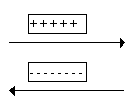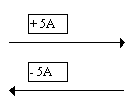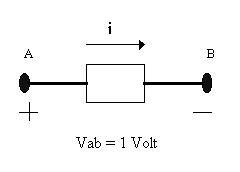| Outline: |
| What is a circuit? |
| The purpose of building a circuit |
| What are elements? |
| The Definition of Current |
| Voltage |
| Energy and Power |
What is a Circuit?
A circuit is a colletion of of electrical elements interconnected in some way, where at least one closed path exists so that current may flow.
| This IS a circuit: |  |
| This is NOT a circuit: |  |
What is the purpose of building a circuit?
The purpose of contructing circuits is to direct current in a specific way such that work can be performed. This is similar to damming a river and forcing the water to flow through turbines which are in turn connected to generators. The idea is that we want to take advantage of our sources of energy to perform some useful work. In this course, our sources of energy are batteries and power supplies.
| Useful work is getting done because current
is flowing from V1 to the resisitor (resistor may be a lightbulb or a stove burner): |
 |
| Current is just flowing into the Ground,
i.e. nothing useful is happening: |
 |
What are elements?
Elements are the individual components or building blocks of a circuit. Some Circuit Components:Top of Page
Resistor: capacitor: Inductor: Battery: Generator: Diode: Inverter: Transistor:
Definition of Current
Current is the flow of charge. It can be defined as either the flow of negative charge (the flow of electrons) or it can be defined as the flow of positive charge. The military typically defines current as the flow of negative charge, however most academic institutions define current as the flow of positive charge. Both conventions are valid when doing circuit analysis.In this class we will ALWAYS assume current is the flow of POSITIVE charge.
negative charge going from right to left:

A Coulomb is the unit used to measure charge.
1 Electron = 1.6021 X 10-19 Coulombs
1 Coulomb = 6.24 X 1018 Electrons
In this class we will describe charge in terms of Coulombs. The Symbol for charge is Q For example: Q = 4C <--- This means the amount of charge is 4 Coulombs In this class we are interested in the FLOW OF CHARGE. Static charge (charge that isn't moving) isn't very useful for getting work done. Charge in motion is called Current.
Current is the flow of charge, i.e. it is the rate of charge moving:
i is the symbol for current:
i = dQ/dt
An Ampere = 1Coulomb/second
1 Amp = 1 C/sec.
5 Amps = 5 C/sec.
The following two currents are exactly the same:

Top of Page
Definition of Voltage
- What moves water from one point to another?
Answer:
- The force of Gravity forces water to move
- from a higher potential energy to a lower
- potential energy.
- What moves electrical charge from one point to another?
Answer:
- EMF (Electromotive Force) is the
- force which moves charge from a
- higher electrical potential energy
- to a lower potential energy.
When an EMF is present and current moves through an element (such as a resistor) then we say that work is being done.
Voltage is the amount of work required
to move 1 Coulomb of charge from one point to another.
Volt = joule/coulomb
Voltage is defined across an element. It is measured between two points.
Consider the picture below:

There is a one volt difference between point-A and point-B
Therefore to move one coulumb of charge from A to B requires 1 joule.
Voltage is always defined between two points, in other words, you need a relative point.
In the picture above Vab = 10 V
(Vab means the voltage at pt-A relative to pt-B)
Or we can say the voltage at pt-A is 10 volts above the voltage at pt-B
Similarly in the picture above Vba = -10 V
(Vba means the voltage at pt-B relative to pt-A)
Or we can say the voltage at pt-B is 10 volts below the voltage at pt-A
Vab = -Vba
The following two circuits are equivalent:
 |
 |
The following two circuits are also equivalent:
 |
 |
Calculating Energy and Power
A circuit element eithers absorbs or delivers energy:
| Here the element is absorbing Energy Current flows into the positive terminal |
 |
| Here the element is delivering Energy Current flows into the negative terminal |
 |
Definition of Power:
The rate that energy is absorbed or delivered by an element.
Let's derive an equation for Power:
V = J/C
dWork = Vdq
dWork/dt = V dq/dt
dWork/dt is Power and dq/dt is current, therefore:
Power = VI
The following table shows some examples of how to calculate power:
| Here the element is absorbing Energy Pabs = VI = 5V(4A)= 20 Watts, or we can say Pdel = -20 Watts Note: Pabsorbed = -Pdelivered |
 |
| Here the element is delivering Energy Pdel = VI = 8V(2A)= 16 Watts, or we can say Pabs = -16 Watts Note: Pabsorbed = -Pdelivered |
 |
| Here the element is absorbing Energy Pabs = VI = -6V(-4A)= 24 Watts, or we can say Pdel = -24 Watts Note: Pabsorbed = -Pdelivered |
 |
| Here the element is delivering Energy Pdel = VI = -9V(5A)= -45 Watts, or we can say Pabs = 45 Watts Note: Pabsorbed = -Pdelivered |
 |
Top of Page
Study Problems
After clicking on the following link enter 1-8 for the problem and 1 for the step:
Study Problem 1-8
After clicking on the following link enter 1-9 for the problem and 1 for the step:
Study Problem 1-9







